
Tokyo
Kanjo
感情
The evening begins in a curious manner – an obscure location that makes you fumble for the map and a handwritten post-it note of the restaurant name casually stuck to the front door. But rest assured, you are in the right place – this is Kanjo, and it is time to feast on duck. Duck lover or not, be wowed by the entertaining service and delectable cuisine.
Climb to the third floor of the narrow staircase of a Roppongi building to find no signboard or draped curtain, just a small square of paper nonchalantly taped to a door. In handwritten Japanese it says, “kanjo“, meaning feeling, emotion, even passion. The characters are the chef’s, a new expression of his feelings each day. Inside, it is a teahouse-style Interior by an architect whose work is in designing restaurants of Japanese cuisine, mostly in Kyoto; it has a minimalist, calming feel that helps you leave all the noise of the world outside. A painting of a duck by Dai Okumura adorns the wall, one of a collection of duck-themed paintings and calligraphy changed monthly.
The spruce timber counter seats six to seven in comfortable Arflex chairs that face the striking Shanghai brick cooking space. With plentiful luxurious ingredients, a highly trained chef, and a location that makes you feel like you are one of the fortunate few to dine on this exquisite duck cuisine, you are in for a treat. Relax and watch as it unfolds before your eyes.
CUISINE
Duck x Soba
At Kanjo, the central ingredient is duck, but the chef demonstrates his versatility with the wonderful array of opening dishes showcasing luxury ingredients like caviar, foie gras, sea urchin, and monkfish liver. These are followed by eight grilled duck dishes, three types of noodle or rice dishes, and dessert. The soba is handmade daily by the chef, as is the bread kneaded with buckwheat.
The meal begins with a beautiful swirl of soba topped with abundant Osetra caviar. The caviar's briny flavor perfectly matches the noodles made purely from Ibaraki-grown Hitachi Aki Soba buckwheat. A sumptuous starter inspired by Peking Duck is a deep-fried duck wing with a crunchy, candied skin, served with homemade sauce. Blue Shark fin is served in a luxuriant duck broth with a dab of premium wasabi. Next, open your mouth wide for a delectable bite carried on a crispy buckwheat cracker featuring brined sea urchin from Yoichi, Hokkaido.
The generous serving of rich, velvety foie gras tops a brioche toast made from dough kneaded with buckwheat. Variations of this dish throughout the year feature sea urchin or caviar. A sushi-style nigiri combines duck breast decorated with intricate knife cuts atop a rice oval infused with rice vinegar and melted duck fat for the ultimate umami. The quality of the fresh duck flesh is on full display in this incredible mouthful, and having been marinated in Chinese rice wine and soy sauce, you could easily mistake it for maguro.
The grilled duck dishes range from tenderloin to neck meat and innards. Because the ducks are asphyxiated, the flesh is unbeatably fresh, allowing the chef to serve parts barely seared. The precious tamahagane steel hotplate is then used to lovingly cook pieces one at a time, gently brushing them with sauce as they sizzle and the aromas emanate, stimulating guests’ appetites. Dining at Kanjo from late November through December presents the chance to try both wild-hunted and farmed duck meat side by side.
Close to 800 bottles of French wines from Burgundy, Champagne, and the New World are on the drinks menu. And because the owner of Kanjo also runs the Roppongi wine bar Owari no Kisetsu, you can order in advance and have a wine of your choice ready and waiting when you dine at Kanjo.
INGREDIENTS
The premium duck meat comes to Kanjo via a route personally cultivated by the chef. There are very few domestic suppliers, and because the limited resources make it impossible to supply other restaurants, Toyoda cannot reveal his. He can tell us that contract hunters use nets during hunting season to catch ducks in Niigata and Miyagi prefectures so as not to damage the duck flesh. The soba served at Kanjo is the premium varietal Hitachi Aki Soba, supplied by one of Japan’s most famed buckwheat growers, known for uniform large fruit with bountiful aroma and sweetness. The soba farmer also provides the Koshihikari rice.


CHEF
Jin Toyoda
Tamahagane Hotplate
The duck is expertly cooked on a hotplate forged by Yoshindo Yoshihara, considered Japan’s most skilled swordsmith. It is made from tamahagane, the most precious form of steel made from iron sand typically used in sword blades. Countless tiny holes dot the steel surface, promoting excellent heat conduction, resulting in incredibly tasty duck meat. The chef’s love for this item can be ascertained from how, each time before use, he carefully removes it from its splendid wooden box adorned with the master swordmaker’s calligraphy strokes. Only found in a few other restaurants, this is the chance to view an item that exemplifies the spirit of Japanese craftsmanship.
Course
- The price includes our booking fee of ¥8,000
- The price includes our booking fee of ¥8,000
- The price includes our booking fee of ¥8,000
- The price includes our booking fee of ¥8,000












